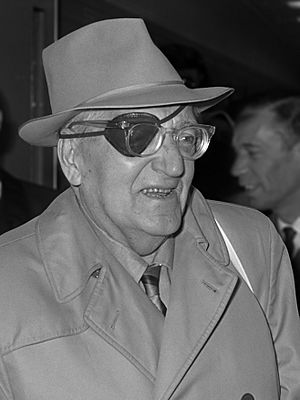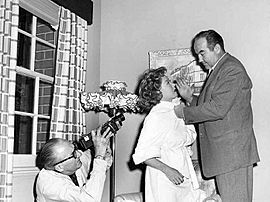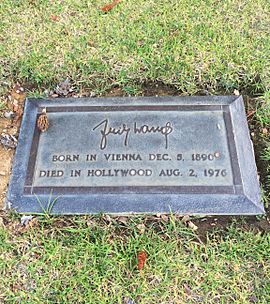Fritz Lang facts for kids
Quick facts for kids
Fritz Lang
|
|
|---|---|

Lang in 1969
|
|
| Born |
Friedrich Christian Anton Lang
December 5, 1890 |
| Died | August 2, 1976 (aged 85) |
| Resting place | Forest Lawn Memorial Park |
| Citizenship |
|
| Alma mater | Technical University of Vienna |
| Occupation |
|
| Years active | 1910–1976 |
| Spouse(s) |
Lisa Rosenthal
(m. 1919; Thea von Harbou
(m. 1922; div. 1933)Lily Latté
(m. 1971) |
Friedrich Christian Anton Lang (December 5, 1890 – August 2, 1976), known as Fritz Lang, was a famous film director, screenwriter, and producer. He was born in Austria and worked in Germany before moving to the United States. He is known as the "Master of Darkness" by the British Film Institute because of the serious and often dark themes in his movies. Many people consider him one of the most important filmmakers ever.
Lang's most famous films include the futuristic Metropolis (1927) and the influential M (1931). Metropolis was one of the first big science fiction movies. His 1929 film Woman in the Moon was special because it showed a multi-stage rocket and was the first to feature a rocket launch pad and a countdown clock before launch. Other important films he made were Dr. Mabuse the Gambler (1922) and Die Nibelungen (1924). After moving to Hollywood in 1934, he directed films like Fury (1936), You Only Live Once (1937), Hangmen Also Die! (1943), and The Big Heat (1953). He became a citizen of the United States in 1939.
Contents
Life and Career
Early Life and Studies
Fritz Lang was born in Vienna, Austria, on December 5, 1890. He was the second son of Anton Lang, who was an architect. His mother, Pauline Lang, was born Jewish but converted to Catholicism. Fritz Lang himself was baptized as a Catholic. He had an older brother named Adolf.
After finishing school, Lang briefly studied civil engineering at the Technical University of Vienna. He then switched to art. In 1910, he left Vienna to travel the world. He explored many parts of Europe, Africa, Asia, and the Pacific. In 1913, he studied painting in Paris.
When World War I started, Lang returned to Vienna. He joined the Austrian army and fought in Russia and Romania. He was wounded four times during the war and lost sight in his right eye. While he was recovering in 1916, he started writing ideas for films. He left the army in 1918 and briefly acted in theater. Soon after, he was hired as a writer for a film company in Berlin called Decla Film.
German Films and Expressionism (1918–1933)
Fritz Lang quickly moved from writing to directing films at German studios like UFA and Nero-Film. This was when the Expressionist movement in art was growing. Expressionism in film used distorted sets, dramatic lighting, and exaggerated acting to show strong emotions or ideas.
Lang made a mix of films during this time. Some were serious dramas like Der Müde Tod ("The Weary Death"). Others were popular thrillers like Die Spinnen ("The Spiders"). He combined exciting stories with the artistic style of Expressionism. This created a new kind of movie that was both entertaining and artistic.
In 1920, Lang met the writer Thea von Harbou. They later married and worked together on all of his films from 1921 to 1933. Their collaborations included Dr. Mabuse, der Spieler ("Dr. Mabuse the Gambler," 1922), which was a very long film shown in two parts. They also made the five-hour epic Die Nibelungen (1924).
One of their most famous films was the dystopian movie Metropolis (1927). This film was very expensive to make and almost caused the UFA studio to go bankrupt. It was not a financial success at first, nor were his last silent films Spies (1928) and Woman in the Moon.
In 1931, Lang directed M for Nero-Film. This was his first "talking" picture, meaning it had sound and dialogue. Many film experts consider M a masterpiece. It tells the unsettling story of a child murderer, played by Peter Lorre, who is hunted by the criminal underworld in Berlin. M is still a powerful film today. Lang was known for being a very demanding director on set.
The films Lang made in Germany often explored themes like psychological conflict, paranoia, fate, and moral questions. These themes later became important parts of a film style called film noir.
Leaving Germany
In late 1932, Lang began filming The Testament of Dr. Mabuse. However, Adolf Hitler and the Nazi party came to power in Germany in January 1933. By March 30, the new government banned Lang's film. They said it could cause public disorder. Some people believe The Testament of Dr. Mabuse was actually a film against the Nazis.
Lang was worried about the Nazi regime. His wife and co-screenwriter, Thea von Harbou, began to support the Nazis in the early 1930s. They divorced in 1933. Lang decided to leave Germany. He claimed that the Nazi propaganda minister, Joseph Goebbels, offered him a job as head of the German film studio UFA. Lang said he decided to leave for Paris during that meeting.
Lang left Berlin for good on July 31, 1933. He moved to Paris, France. There, he made one French film called Liliom, starring Charles Boyer. After that, he moved to the United States.
Hollywood Career (1936–1957)
Fritz Lang made 23 films during his 20 years in Hollywood. He worked in many different film styles and for all the major studios. He became a citizen of the United States in 1939.
His first film in Hollywood was the crime drama Fury (1936) for MGM Studios. It starred Spencer Tracy as a man wrongly accused of a crime. Lang also made several films with a clear anti-Nazi message, such as Man Hunt (1941), Hangmen Also Die! (1943), and Cloak and Dagger (1946).
At first, some critics thought his American films were not as good as his earlier German works. However, his American films are now seen as very important for the development of American genre cinema, especially film noir. Scarlet Street (1945), starring Edward G. Robinson and Joan Bennett, is considered a key film in this style.
One of Lang's most praised film noirs is the police drama The Big Heat (1953). It is known for its intense scenes. As Lang got older, his films became more serious and often showed a pessimistic view of the world. This can be seen in his last American films, While the City Sleeps (1956) and Beyond a Reasonable Doubt (1956).
Last Films (1959–1963)
As he got older and his health declined, Lang found it harder to find good opportunities in Hollywood. He thought about retiring. However, a German producer named Artur Brauner wanted to remake an old story that Lang had worked on. So, Lang returned to Germany to make his "Indian Epic," which included The Tiger of Eschnapur and The Indian Tomb.
After these films, Brauner planned to remake The Testament of Dr. Mabuse. Lang suggested adding a new film to the series, which resulted in The Thousand Eyes of Dr. Mabuse (1960). This film was a success and led to more Mabuse movies, though Lang did not direct them. Lang was almost blind during the making of The Thousand Eyes of Dr. Mabuse, and it was his last film as a director.
In 1963, he appeared as himself in the film Contempt by Jean-Luc Godard.
Death and Legacy
On February 8, 1960, Fritz Lang received a star on the Hollywood Walk of Fame for his important contributions to movies. His star is located at 1600 Vine Street.
Fritz Lang died from a stroke in 1976. He was buried in the Forest Lawn Hollywood Hills Cemetery in Los Angeles.
Even though his career ended quietly, many film critics and directors, especially from France, admired Lang's work. Filmmakers like François Truffaut and Jacques Rivette praised his movies, especially his American ones. Many famous directors have been influenced by his work, including Steven Spielberg, Christopher Nolan, Alfred Hitchcock, and Stanley Kubrick.
Lang is known for helping to start or develop many different types of films.
Filmography
Awards
- Silver Hand in 1931, for his film M, from the German Motion Picture Arts Association
- Commander Cross, Order of Merit in 1957 and 1966
- Golden Ribbon of Motion Picture Arts in 1963 from the Federal Republic of Germany
- Order of Arts and Letters from France in 1965
- Plaque from El Festival Internacional del Cine de San Sebastian in 1970
- Order of the Yugoslavia Flag with a Golden Wreath in 1971
- Honorary Professor of Fine Arts by the University of Vienna, Austria, in 1973
See also
 In Spanish: Fritz Lang para niños
In Spanish: Fritz Lang para niños




